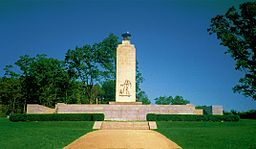Eternal Light Peace Memorial
| Eternal Light Peace Memorial | |
| historic district contributing structure | |
|
The memorial has "The Flame of Eternal Peace" and relief sculptures of two women and an American eagle.
|
|
| Country | United States |
|---|---|
| State | Pennsylvania |
| County | Adams |
| NPS unit | Gettysburg National Military Park |
| Location | Oak Hill |
| - coordinates | 39°50.894′N 77°14.599′W / 39.848233°N 77.243317°WCoordinates: 39°50.894′N 77°14.599′W / 39.848233°N 77.243317°W |
| Highest point | Flame urn (protection for rain & wind up to 40 mph) |
| - coordinates | 39°50′55″N 77°14′36″W / 39.848474°N 77.243451°W |
| Bidding Dedication |
January 1938 |
| Management | National Park Service |
| Owner | US federal government |
| Parking | along Confederate Av (entrance along Mummasburg Rd) |
| GNMP structure | MN006 |
| Architect Sculptor Builder |
Paul Philippe Cret Lee Lawrie |
| Shaft Base |
Alabama Rockwood Limestone Maine granite |
| Website: Park Scenes (nps.gov) | |
The Eternal Light Peace Memorial is a 1938 Gettysburg Battlefield monument commemorating the 1913 Gettysburg reunion for the fiftieth anniversary of the 1863 Battle of Gettysburg. The natural gas flame in a one-ton bronze urn is atop a tower on a stone pedestrian terrace with views from the terraced hill summit over about 400 sq mi (1,000 km2), and the flame is visible from 20 mi (32 km) away.
In 1887, "the Philadelphia Brigade, Col. Cowan and others" advocated a "grand monument to American Heroism on this battlefield", and President William McKinley spoke to Cowan about North/South peace in 1900. The "first tentative program" of October 1910 for the 1913 Gettysburg reunion planned a "Peace Jubilee" to be held on "National Day" with an oration by President Woodrow Wilson and the cornerstone placement for the "Great Peace Memorial" at noon. However, after being "presented, January 11th, 1912, to the Joint Committee of the Congress [for] the Celebration of the Fiftieth Anniversary of the Battle of Gettysburg", funding was "found, in March 1912, impossible of accomplishment in the 62nd Congress". Instead of the laying of a cornerstone, on July 3 during the New York Veterans' Celebration in the 1913 Great Tent, Colonel Andrew Cowan gave a speech advocating the memorial, and "steps to accomplish such purpose were immediately taken … which resulted in the Gettysburg Peace Memorial Association being formed. … That Association's Bill was, on December 20th, 1913, presented to Congress…creating the Gettysburg Memorial Commission."
The original plan was for a $250,000 "monument of peace" at The Angle, but despite 1914 "Peace Memorial Bill" presentations to the US House of Representatives that compared the planned memorial with Christ the Redeemer of the Andes and the Lincoln Memorial, federal funding remained "postponed". In August 1936, the memorial's commission issued 10,000 four page circulars to publicize the plan, and Virginia in 1936 was the first to appropriate funds. In 1937 the Pennsylvania legislature began planning a peace memorial on Big Round Top, and the state's "Peace Memorial Bill" was signed on February 24, 1937, to appropriate $5,000 for the state's "Gettysburg Peace Memorial fund". The peace memorial committee selected from the 6 designs by August 1937 and on December 10, 1937, Lee Lawrie was announced as the sculptor for the structure "overlooking Big Round Top [and] Little Round Top". With additional funding by New York, Indiana, Tennessee, Illinois, and Wisconsin; the $60,000 monument was instead completed northwest of Gettysburg, Pennsylvania. Groundbreaking was on February 14, and the last foot of piping for the flame's gas supply was placed on May 31.
...
Wikipedia

